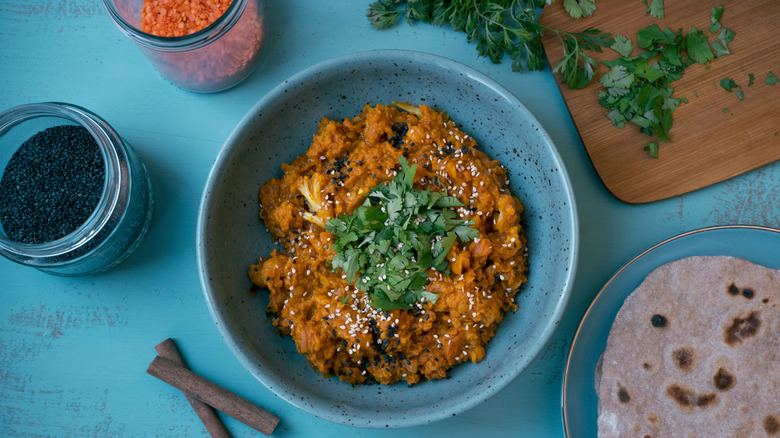There’s something about the imagery of a pot of tomato beans simmering on the stovetop, infusing the kitchen with savory aromas, and ready to be soaked up with rustic bread that conjures a sense of comfort. But, what if we told you there’s an easy hack to make a simple serving of tangy tomato beans extra flavorful and decadently creamy without any dairy or additional ingredients? It all boils down to the last few minutes of cooking, when all you need to do is mash some of the cooked white beans or blend half of the mixture with an immersion blender to release the starches from the beans that will thicken up the sauce. No extra flour, cornstarch, or cream is needed, and yet, you’ll have a pot of tomato beans with a luscious, velvety texture and elevated flavor. If you don’t have an immersion blender, pressing down with the back of a spoon or spatula does the trick to crush the softened beans such that they melt into the vibrant tomato sauce.
This technique also creates a delectable textural contrast between the creamy beans, the sauce, and the satisfying bite from the cooked beans that are left intact. Buttery white bean varieties like broad butter beans, cannellini beans, and Northern beans work best, owing to their soft, buttery mouthfeel when cooked. The pockets of creaminess throughout the dish from the starches released by mushing the beans transform the humble tomato bean stew into an elegant, restaurant-worthy meal. For extra umami flavor, add nutritional yeast for a thick, creamy, cheesy-tasting bowl of tomato beans sans dairy. Pair with crusty bread, serve atop pearl couscous, or even as a hearty pasta sauce, and enjoy.
Explore this hack with other legume-based dishes
Smashing the beans towards the end of cooking is by no means a novel discovery. In fact, home cooks and chefs from across the world have been using this handy trick in family recipes for generations. Sometimes this optional step serves different purposes in addition to imparting a silky smooth mouthfeel in every spoonful. When it comes to traditional daal, red lentils (masoor daal) are the usual default choice. While the “low and slow” cooking approach will naturally break down the lentils to the desired consistency, deliberately mashing a portion can speed up the process. This method is certainly ideal for impatient diners eager to dig in to this iconic Indian comfort food, and warrants being added to your list of tips for tasty homemade daal. The same approach can apply when cooking yellow split pea daal. For thicker lentil dishes like dal makhani, roughly mashing the black lentils (urad dal) adds a textural variety and helps intensify the richness that is characteristic of this North Indian specialty.
When it comes to the beloved Middle Eastern breakfast food ful medames, which uses peeled fava beans, partially mashing the beans creates the ideal consistency for scooping the aromatic, protein-packed stew with fresh flatbread. Connoisseurs of Mexican cuisine can attest to the difference in mouthfeel when pairing rice with refried beans versus beans that have just been cooked and seasoned. The mashing technique is to thank for the added buttery creaminess of refried beans that works wonders given its simplicity. Whether you’re passionate about cooking with more legumes or excited to treat your taste buds to spices and flavors from across the globe, tantalize them even further with this small but mighty technique that transcends international borders.






